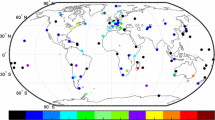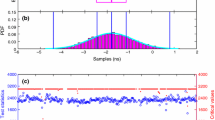Abstract
Deriving the ionospheric total electron content (TEC) from the global navigation satellite systems (GNSS) measurements typically assumes the receiver differential code biases (RDCBs) to remain unchanged within at least 1 day. However, the RDCBs sometimes can exhibit remarkable intraday variability, probably due to the ambient temperature fluctuation. The modified carrier-to-code leveling (MCCL) method enables one to eliminate the adverse impact of the short-term variations of RDCBs (called RDCB offsets) on the retrieval of ionospheric TECs. In this study, we extend the GPS-only MCCL method to the multi-GNSS case and further carry out a series of investigations. First, in terms of the Pearson correlation coefficient (PCC), the dependence of multi-GNSS RDCB offsets upon ambient temperature is verified. As suggested by the results, a strong linear correlation exists between the estimated RDCB offsets and measured temperature values. The percentages of the stations analyzed with the absolute PCC values above 0.5 are 76.5%, 94.1% and 64.2% for GPS, BDS and Galileo, respectively. Second, the global ionospheric map provided by the center for orbit determination in Europe (CODE), the JASON altimeter and the difference of slant TEC (dSTEC) are chosen as the references for evaluating the performance of MCCL-derived TECs. After removing the significant RDCB offsets, an improvement of 69.7%, 93.4% and 87.6% for GPS, BDS and Galileo has been achieved in the dSTEC validation, respectively.














Similar content being viewed by others
References
Abdelazeem M, Çelik RN, Elrabbany A (2016) An efficient regional ionospheric model using combined GPS/BeiDou observations. Spat Sci 62:1–13
Banville S, Langley RB (2011) Defining the Basis of an “Integer-Levelling” Procedure for estimating slant total electron content. In: Proceedings of ION GNSS 2011, Institute of Navigation, Portland, Oregon, USA, September 20–23, pp 2542–2551
Ciraolo L, Azpilicueta F, Brunini C, Meza A, Radicella SM (2007) Calibration errors on experimental slant total electron content (TEC) determined with GPS. J Geodesy 81(2):111–120
Coster A, Williams J, Weatherwax A, Rideout W, Herne D (2013) Accuracy of GPS total electron content: GPS receiver bias temperature dependence. Radio Science 48(2):190–196
Hernández-Pajares M (2010) Section 9.4 Ionospheric model for radio techniques of chapter 9 Models for atmospheric propagation delays of IERS Conventions 2010. IERS technical note (36)
Hernández-Pajares M (2011) The ionosphere: effects, GPS modeling and the benefits for space geodetic techniques. J Geodesy 85(12):887–907
Hernández-Pajares M, Roma-Dollase D, Krankowski A, García-Rigo A, Orús-Pérez R (2017) Methodology and consistency of slant and vertical assessments for ionospheric electron content models. J Geodesy 91(12):1405–1414
Janssen V (2009) Precision rules! How to establish an AusCORS site. Position 44:64–66
Kao S, Tu Y, Chen W, Weng DJ, Ji SY (2012) Factors affecting the estimation of GPS receiver instrumental biases. Empire Survey Review 45(328):59–67
Li M, Yuan Y, Wang N, Li Z, Li Y, Huo X (2017a) Estimation and analysis of Galileo differential code biases. J Geodesy 91(3):279–293
Li M, Yuan Y, Wang N, Liu T, Chen Y (2017b) Estimation and analysis of the short-term variations of multi-GNSS receiver differential code biases using global ionosphere maps. J Geodesy 4:1–15
Li M, Yuan Y, Zhang B, Wang N, Li Z, Liu X, Zhang X (2017c) Determination of the optimized single-layer ionospheric height for electron content measurements over China. J Geodesy 92(1):1–15
Liu T, Zhang B, Yuan Y, Li M (2018) Real-time precise point positioning (RTPPP) with raw observations and its application in real-time regional ionospheric VTEC modeling. J Geodesy 1:1–17
Mannucci AJ, Wilson BD, Edwards CD (1993) A new method for monitoring the Earth ionosphere total electron content using the GPS global network. In: Proceedings of ION GPS 1993, Institute of Navigation, Salt Lake City, UT, vol 2, September 22, pp 1323–1332
Mannucci AJ, Wilson BD, Yuan DN, Ho CH, Lindqwister UJ, Runge TF (1998) A global mapping technique for GPS-derived ionospheric total electron content measurements. Radio Sci 33(3):565–582
Mohamed A, Ahmed ER (2016) MGR-DCB: a precise model for multi-constellation GNSS receiver differential code bias. J Navig 69(4):698–708
Montenbruck O, Hauschild A, Steigenberger P (2015) Differential code bias estimation using multi-GNSS observations and global ionosphere maps. Navigation 61(3):191–201
Ren X, Zhang X, Xie W, Zhang K, Yuan Y, Li X (2016) Global ionospheric modelling using multi-GNSS: BeiDou, Galileo, GLONASS and GPS. Sci Rep 6:33499. https://doi.org/10.1038/srep33499
Rizos C, Montenbruck O, Weber R, Weber G, Neilan R, Hugentobler U (2013) The IGS MGEX experiment as a milestone for a comprehensive multi-GNSS service. In: Proceedings of ION Pacific PNT meeting 2013, Institute of Navigation, Honolulu, Hawaii, April 23–25, pp 289–295
Roma-Dollase D et al (2017) Consistency of seven different GNSS global ionospheric mapping techniques during one solar cycle. J Geodesy 4:1–16
Sardón E, Zarraoa N (1997) Estimation of total electron content using GPS data: how stable are the differential satellite and receiver instrumental biases? Radio Science 32(5):1899–1910
Schaer S (1999) Mapping and predicting the Earth’s ionosphere using the Global Positioning System. Geod-Geophys Arb Schweiz 59:59
Teunissen P (1985) Zero order design: generalized inverses, adjustment, the datum problem and S-transformations. Springer, Berlin, pp 11–55
Teunissen PJG (2012) A-PPP: array-aided precise point positioning with global navigation satellite systems. IEEE Trans Signal Process 60(6):2870–2881
Teunissen PJG, Montenbruck O (2017) Springer handbook of global navigation satellite systems. Springer, Berlin
Wang N, Yuan Y, Li Z, Montenbruck O, Tan B (2016) Determination of differential code biases with multi-GNSS observations. J Geodesy 90(3):209–228
Yuan Y, Ou J (2004) A generalized trigonometric series function model for determining ionospheric delay. Prog Nat Sci 14(11):1010–1014
Zhang B, Teunissen PJG (2016) Zero-baseline analysis of GPS/BeiDou/Galileo between-receiver differential code biases (BR-DCBs): time-wise retrieval and preliminary characterization. Navigation 63(2):181–191
Zhang BC, Yuan YB, Li ZS, Ou JK (2012) Extraction of line-of-sight ionospheric observables from GPS data using precise point positioning. Sci China Earth Sci 55(11):1919–1928
Zhang DH, Shi H, Jin YQ, Zhang W, Hao YQ, Xiao Z (2014) The variation of the estimated GPS instrumental bias and its possible connection with ionospheric variability. Sci China Technol Sci 57(1):67–79
Zhang R, Song W, Yao Y, Shi C, Lou Y, Yi W (2015) Modeling regional ionospheric delay with ground-based BeiDou and GPS observations in China. GPS Solut 19(4):649–658
Zhang B, Teunissen PJG, Yuan Y, Zhang H, Li M (2018a) Joint estimation of vertical total electron content (VTEC) and satellite differential code biases (SDCBs) using low-cost receivers. J Geodesy 92(4):401–413
Zhang B, Teunissen PJG, Yuan Y, Zhang X, Li M (2018b) A modified carrier-to-code leveling method for retrieving ionospheric observables and detecting short-term temporal variability of receiver differential code biases. J Geodesy 3:1–10
Acknowledgements
This work was partially funded by the National key Research Program of China “Collaborative Precision Positioning Project” (No. 2016YFB0501900) and the National Natural Science Foundation of China (Nos. 41604031, 41774042, 41621091, 41804037). The second author is supported by the CAS Pioneer Hundred Talents Program. The third author acknowledges LU JIAXI International team program supported by the K.C. Wong Education Foundation and CAS. Many thanks go to the IGS MGEX (ftp://cddis.gsfc.nasa.gov) and AUSCORS (ftp://ftp.ga.gov.au) for providing access to multi-GNSS data and meteorological data as well as GIM products.
Author information
Authors and Affiliations
Corresponding author
Additional information
Publisher's Note
Springer Nature remains neutral with regard to jurisdictional claims in published maps and institutional affiliations.
Rights and permissions
About this article
Cite this article
Zha, J., Zhang, B., Yuan, Y. et al. Use of modified carrier-to-code leveling to analyze temperature dependence of multi-GNSS receiver DCB and to retrieve ionospheric TEC. GPS Solut 23, 103 (2019). https://doi.org/10.1007/s10291-019-0895-2
Received:
Accepted:
Published:
DOI: https://doi.org/10.1007/s10291-019-0895-2




